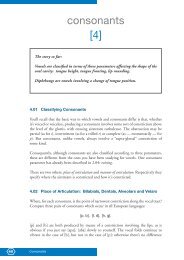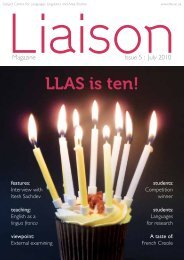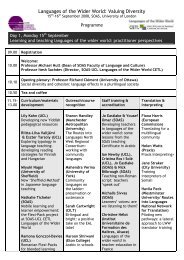PHONETICS MANUAL.indd - HumBox
PHONETICS MANUAL.indd - HumBox
PHONETICS MANUAL.indd - HumBox
Create successful ePaper yourself
Turn your PDF publications into a flip-book with our unique Google optimized e-Paper software.
Fig. 35<br />
[m] [p, b]<br />
If the oral closure is alveolar instead of bilabial, [n] is the result. (The slightly different<br />
shape of the oral cavity gives rise to a slightly different sound wave). As you might<br />
expect, the [n] of French, Spanish or Italian — like the corresponding stops — is<br />
dental not alveolar: [n]. 9<br />
Also to be noted is the velar nasal, which is of frequent occurrence in English (ng in<br />
the spelling, e.g. singer, singing). This has the same place of articulation as [k] and [g],<br />
but the same manner of articulation as [m] and [n], specified above. The IPA uses the<br />
symbol [Œ] for this sound: [sIŒ@], [sIŒIŒ]. Its official name is “eng”.<br />
At least that’s the RP pronunciation of singer, singing. Many speakers in the UK always have<br />
a [g] after their [Œ] and therefore pronounce these words [sIŒg@], [sIŒgIŒg]. In RP the [g]<br />
is present only in the pronunciation of some words: finger for example [fIŒg@] (where er is<br />
not a suffix).<br />
Fig. 36 shows the resemblance between [Œ] and [k] — and the crucial difference: the<br />
lowered velum in the case of [Œ].<br />
Fig. 36<br />
[Œ]<br />
[k]<br />
Here is the nasal row of the consonant chart, with an impressive array of symbols<br />
included. The palatal nasal m (“left-tail N”) occurs in French (signe) and Spanish<br />
(señor). Note that a few languages outside Europe even make use of a uvular nasal.<br />
Fig. 37<br />
bilabial<br />
dental<br />
alveolar<br />
palatal velar uvular<br />
labiodental<br />
postalveolar<br />
pharyngeal<br />
glottal<br />
m Õ n n Æ Œ N<br />
9<br />
56 Consonants






